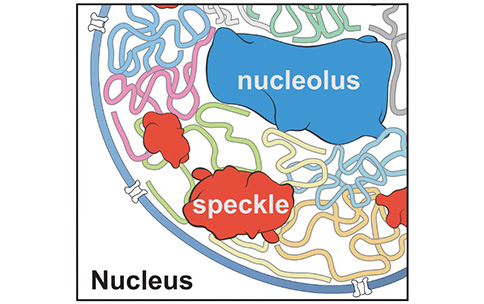
The 3D organization of DNA in the nucleus of a cell plays an important role in determining which genes are turned on in that cell. This has important implications for human health, as problems with DNA organization are linked to human diseases such as cancer and early aging. Understanding how the DNA is organized in healthy cells is a critical step in identifying targets and developing treatments for abnormal nuclear organization. A current method for mapping 3D genome organization uses a technique called “proximity ligation” in which regions of DNA that are very close together, or “touching,” are linked together and then sequenced to determine where these DNA “touches” occur. This technique mostly identifies interactions of DNA regions within the same chromosome. However, imaging of the genome using microscopy techniques has shown that there are interactions between chromosomes and that these interactions tend to occur at discrete regions of the nucleus known as nuclear bodies. This indicates limitations of proximity ligation techniques in identifying interactions between chromosomes that occur over longer-range distances. In addition, both proximity ligation and microscopy techniques are limited to measuring simultaneous contacts between a small number of DNA regions, making it difficult to develop a comprehensive model of global genome organization.
A recent study led by NIH Common Fund 4D Nucleome Program-funded investigator Dr. Mitchell Guttman, developed a new technique for detecting simultaneous genome-wide interactions within the nucleus, called Split-Pool Recognition of Interactions by Tag Extension (SPRITE). SPRITE works by linking interacting DNA, RNA, and proteins in cells, isolating the nuclei, fragmenting the chromatin, “barcoding” interacting molecules within a complex, and sequencing and matching the areas with identical “barcodes” to identify interacting regions. Unlike proximity ligation and microscopy techniques, SPRITE is not limited in the number of simultaneous DNA interactions that it can identify. Using SPRITE, they were able to detect interactions that occur across larger distances than those found by proximity ligation techniques. They found two “hubs” of interactions between chromosomes, both associated with nuclear bodies: an inactive gene-poor hub that organizes around the nucleolus and an active gene-rich hub that organizes around regions called “nuclear speckles.” Using the SPRITE results, they created a global model of 3D genome organization, in which nuclear bodies act as inter-chromosomal hubs that shape the 3D packaging of DNA in the nucleus.
Reference
- Higher-order inter-chromosomal hubs shape three-dimensional genome organization in the nucleus. Quinodoz, SA, Ollikainen, N, Tabak, B, Palla, A, Schmidt, JM, Detmar, E, Lai, MM, Shishkin, AA, Bhat, P, Takei, Y, Trinh, V, Aznauryan, E, Russell, P, Cheng, C, Jovanovic, M, Chow, A, Cai, L, McDonel, P, Garber, M, and Guttman, M. Cell. 2018.


